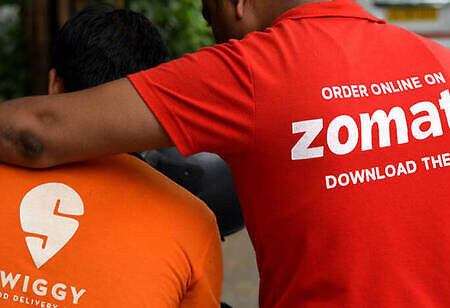
What's Cookin? Zomato or Swiggy?


Swiggy and Zomato are clearly what comes to mind when it comes to dining in, to the point that it is no surprise if they happen to be one of the most used apps in smartphones. Consumers who have relied have tasted a fair share of both services, not only showcasing healthy competition in the food tech market, but the indecisiveness among consumers who must choose one when it comes down to it. Yet two of these rivals decided to turn the fire from their competitive spirit into a heart-warming gentle atmosphere that had the crowd bask in delight on the dawn of the New Year.
As both food tech platforms hit an all-time high in sales on New Year’s Eve 2021 clocking the number of users who had relied on their services while they stayed indoors. This joy was shared on Twitter with Deepinder Goyal, CEO, Zomato who shared the news of the food tech platform that achieved 2.5 million orders within a day, including what people ordered, tipping delivery agents, success rates of various payment methods and more.
Soon Swiggy’s CEO, Sriharsha Majety also hopped in on the vibe by sharing NYE tidbits about the platform.
“Planning on getting out of my comfort zone (my Twitter cave) too today to share NYE tidbits on Swiggy”, wrote a joyful Majety.
This tweet further tagged journalist Chandra Srikanth, who proposed a match between the two food tech giants.
“Zomato vs Swiggy! Bring it on Deepinder Goyal and Sriharsha Majety. What are you two eating tonight btw?”.
Majety responded by tweeting, “Hahaha this isn’t a fair competition. I’m just learning the ropes”.
While this whipped up a sweet aroma among the crowd, Zomato’s CEO sugar coated that by tweeting, “You will do amazing! Come on, let's do this”.
The Chow-Down of Swiggy and Zomato!
Zomato reported gross merchandise value (GMV) of over Rs 100 crore, up from Rs 75 crore last year on December 31. Here the GMV refers to the value of food ordered on Zomato's website. Swiggy, an arch-rival, reported a 62 percent increase in orders delivered and a 61 percent increase in GMV over the previous year.
Swiggy claimed that it surpassed two million orders, while Zomato claims to have surpassed 2.5 million.
Both food tech’s CEOs live-tweeted the orders per minute (OPM) in an aggressive push to highlight the demand rise. At the time, the two had broken the record of 7,000 orders per minute.
“The ongoing surge in the number of guests preferring to stay home (led to) a lower-than-expected turnout at some of the restaurants, which (in turn) led to increased online orders”, said AD Singh, managing director of Olive group of restaurants, which operates 15 brands such as Monkey Bar, Guppy and The Fatty Bao across six cities.
He went on to say that the online orders were nearly double what he sees on a busy weekend.
Even while the number of new users climbed by 80 percent, Swiggy's order per minute hit 9,500 in the evening, breaking last year's record by 1.7 times.
The majority of orders on New Year's Eve were placed through online channels, according to Jimmy Kuruvilla, vice-president of operations at Food Matters Group, which operates high-end restaurants such as The Table in Mumbai.
Swiggy and Zomato have been expanding their delivery fleets, support and operations staff in preparation of a record jump in orders. Speaking of preparations, both entities have started to get those New Year resolutions cooking by collecting five percent GST.
First Mission of the Year
Both entities believe that the collection and deposit tax of five percent will widen the tax base for those entities, who are excluded from the GST threshold, will become liable to GST when provided through these online platforms.
EY India Tax Partner Bipin Sapra said “this change will have an immediate impact on working capital of taxpayers who are currently availing credit of 105 percent of matched credit. The change will also mandate industry to validate that the procurements are made from genuine and compliant vendors”.
While the amendment is anticipated to reduce the practice of passing input tax credit by declaring in GSTR-1 without paying taxes in GSTR 3B, legitimate disparities between GSTR-1 and GSTR 3B, such as carry forward of unadjusted credit notes, are likely to be subjected to undue scrutiny, according to Sapra.
The measure is meant to reduce the risk of fraudulent invoicing, in which sellers report larger sales in GSTR-1 to allow customers to claim ITC, but reduced sales in GSTR-3B to reduce GST liabilities.
This amendment, according to Sapra, is also believed to broaden the tax base as food merchants who are currently outside the GST threshold will be liable for GST if their services are offered through these online platforms. As a result, purchasing through these platforms is more expensive.
“Given that restaurants sometimes supply goods along with restaurant services, an invoice may have multiple payments by multiple people and hence would involve complexity of operations. This practice of laying burden on E-Commerce operators for supplies made through them is putting additional burden on a platform which is just facilitating the supply,” Sapra added.
E-commerce operators are now liable to pay GST in place of restaurants, according to Nexdigm Executive Director (Indirect Tax) Saket Patawari, and the tax base of the government may expand as a result of this, as these operators will be accountable to GST even for unregistered eateries.
“E-com operators may be asked to obtain registration in each State where restaurants are located even if they don’t have presence and undertake all the regular GST compliances even if they don’t have any infrastructure in the State. It may become a challenge to handle audits and investigations in all the states esp. for start-ups and new E-com operators,” Patawari added.